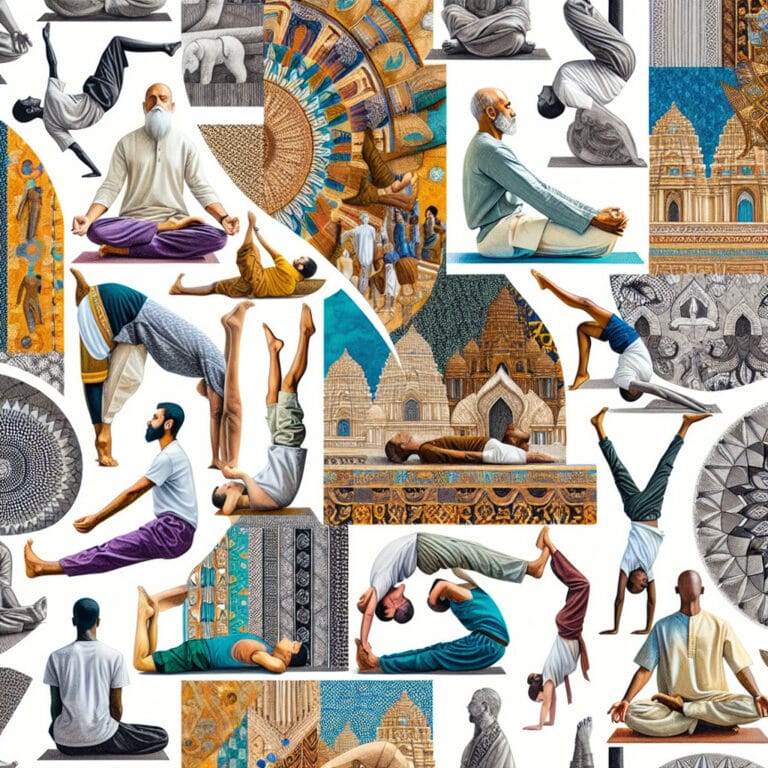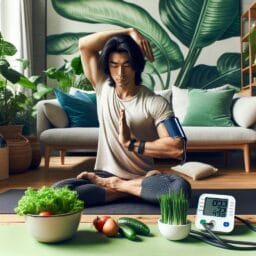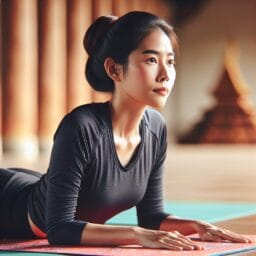
Top Yoga Poses for Alleviating Varicose Veins
Table of Contents
- Introduction
- Understanding Varicose Veins
- Yoga and Varicose Veins
- Top Yoga Poses for Alleviating Varicose Veins
- Tips for Practicing Yoga with Varicose Veins
- Conclusion
- References
- Frequently Asked Questions
Introduction
Varicose veins are a common vein disease that affect many people worldwide, characterized by swollen, twisted blood vessels commonly located in the lower extremities. A regular yoga practice can be an effective means to manage varicose veins and may even help prevent their formation. The gentle stretching and strengthening of yoga poses can improve circulation, allowing blood to flow more efficiently through the body. This alleviates pressure on the veins in your legs, decreasing swelling and discomfort associated with varicose veins. Furthermore, certain yoga poses focus on elevating your legs or engaging your upper body and back muscles which effectively direct blood flow away from lower limbs and reduce stress on the affected areas. Beyond physical benefits, yoga also integrates philosophical aspects into its teaching – promoting relaxation and stress reduction which indirectly aid in managing vein conditions by improving overall vascular health. While not a replacement for medical treatments like endovenous laser treatment for severe cases, yoga exercises offer a holistic approach complementing conventional varicose vein treatments.
Understanding Varicose Veins
Varicose veins, a common vein disease that causes blood vessels in the lower extremities to become swollen and twisted, can significantly impede daily activities and overall health. This condition is typically characterized by feelings of heaviness, tiredness, pain, and even restlessness in the legs. It may also lead to swelling in the ankles and feet, itching over the affected area or muscle cramps. The presence of these symptoms often results in discomfort during physical tasks involving standing or walking for prolonged periods. Moreover, this circulatory issue can have wide-ranging implications on an individual’s life beyond physical discomfort – it might lead to self-consciousness about appearance due to visible blue or dark purple veins which can impact mental wellbeing too.
Fortunately, yoga offers a path to manage varicose veins without resorting immediately to invasive treatments such as endovenous laser treatment. Specific yoga poses aimed at improving circulation can direct blood flow away from your lower extremities thereby relieving pressure off your swollen veins. By distributing body weight evenly across all limbs during certain poses (asanas), yoga exercises alleviate stress placed on affected areas reducing swelling considerably over time.
In addition, incorporating targeted upper body and upper back workouts into your routine ensures improved blood circulation throughout the body diminishing strain on any one particular region such as the legs or ankles often implicated in varicose vein conditions.
The philosophical aspects integrated within yoga teaching emphasize mindfulness and relaxation techniques proven effective against chronic stress – a known contributor towards poor vascular health. An extensive knowledge on integrating these practices prior is beneficial not just for managing existing vein diseases but also preventing onset of new ones through maintenance of good vascular health.
Yoga and Varicose Veins
Integrating yoga into your daily routine can serve as a transformative approach to manage varicose veins. Yoga exercises, including specific poses or asanas prior, are more than just physical workouts; they also engage philosophical aspects of mindfulness and relaxation that contribute to overall vascular health. Regular practice not only enhances blood circulation but also promotes balanced distribution of body weight, relieving undue pressure on the lower extremities often affected by this vein disease. As you transition through sequences focusing on upper body and back strength, the improved circulation diverts blood flow away from swollen veins in your legs, aiding in reducing their appearance and alleviating swelling. Additionally, the stress reduction benefits inherent in yoga teaching have significant positive impacts on vascular health. Thus for individuals seeking extensive knowledge on non-invasive methods to treat varicose veins or complement conventional treatments like endovenous laser treatment, incorporating a practice such as yoga could be an empowering measure towards healthier living.
Top Yoga Poses for Alleviating Varicose Veins
The practice of yoga is often lauded for its ability to harmonize the mind, body, and spirit. Less known, however, are its potential benefits for those grappling with varicose veins – a common vein disease that can cause discomfort and self-consciousness. Regular participation in yoga exercises can provide relief from this condition by improving blood circulation and reducing stress.
One powerful asana for managing varicose veins is Viparita Karani or Legs-Up-The-Wall Pose. This simple yet effective pose involves lying on your back with your legs elevated against a wall or bolster. The pose stimulates blood flow away from the lower extremities that are typically impacted by varicose veins. It’s also an excellent posture for relieving pressure on swollen veins, thereby helping to alleviate swelling.
Sarvangasana or Shoulder Stand is another beneficial pose for those with varicose veins. By inverting the body’s usual stance and placing more weight onto the upper back and shoulders, this pose rechannels blood circulation away from areas typically strained by excess body weight – like our legs – towards healthier regions instead.
Adho Mukha Svanasana or Downward-Facing Dog offers similar advantages but adds an element of stretching that extends all the way from your hands through your spine down to your heels. By lifting up through your hips and pressing back into your heels, you encourage efficient blood flow throughout the entire body which indirectly aids in managing conditions like varicose veins.
Tadasana or Mountain Pose comes highly recommended too thanks to its focus on grounding one’s feet firmly on earth while aligning rest of the body right up till crown of head – promoting balanced distribution of weight across limbs mitigating undue stress on any one area like lower extremities often affected in cases of vein diseases.
Last but not least, Padangusthasana or Big Toe Pose emphasizes forward bending movement inviting fresh oxygenated blood towards head region. This gentle inversion can be instrumental in managing varicose veins as it facilitates return of blood from legs back to the heart, reducing pressure on affected veins while encouraging healthy circulation.
Incorporating these yoga poses into your regular routine, coupled with an understanding of their philosophical aspects and benefits, can provide extensive knowledge for those looking to manage or even treat varicose veins naturally. Though not substitutes for medical treatments such as endovenous laser treatment for severe cases, they offer a holistic and empowering approach towards healthier living.
Tips for Practicing Yoga with Varicose Veins
With a focus on holistic wellness, yoga provides an empowering path to manage varicose veins – a common vein disease that impacts the blood vessels in the lower extremities. Regular participation in specific yoga exercises can help improve circulation and relieve pressure on these affected areas, stimulating healthy blood flow and reducing the swelling associated with this condition. Beneficial poses such as Viparita Karani or Legs-Up-The-Wall Pose, Sarvangasana or Shoulder Stand, Adho Mukha Svanasana or Downward-Facing Dog not only redistribute body weight evenly across all limbs but also encourage upper body and upper back strength- diverting blood flow away from swollen veins. Beyond its physical benefits, yoga’s philosophical aspects underscore mindfulness and stress reduction – key components for vascular health. While it’s essential to remember that yoga is not a substitute for medical procedures like endovenous laser treatment in severe cases of varicose veins, integrating this practice into your lifestyle can certainly augment conventional treatments, offering extensive knowledge tools for healthier living.
Conclusion
As we journey towards comprehensive health, yoga emerges as a powerful ally in managing varicose veins – a common vein disease affecting the lower extremities. Practicing specific yoga poses regularly can significantly improve blood circulation and relieve pressure on affected areas, orchestrating healthy blood flow and alleviating swelling. Learning from the philosophical aspects of yoga teaching prompts us to reduce stress – an important stride towards vascular health. Adopting this routine not only promotes balanced body weight across limbs but also strengthens our upper body and back, redirecting blood flow away from swollen veins. While conventional treatments like endovenous laser treatment exist, incorporating targeted yoga exercises into your daily regimen offers an empowering path to manage varicose veins naturally.
References
Integrating yoga into your daily regimen offers surprising benefits for managing varicose veins, a common vein disease. Regular practice of specific yoga poses can significantly improve circulation, relieve pressure on affected blood vessels in the lower extremities, and stimulate healthy blood flow — effectively reducing the swelling associated with this condition. Beyond its physical advantages, the philosophical aspects of yoga teaching underscore mindfulness and stress reduction — key components in promoting vascular health. Balancing body weight evenly across all limbs and strengthening upper body and back muscles help divert blood flow away from swollen veins. While not substitutes for conventional treatments like endovenous laser treatment for severe cases of varicose veins, adopting these yoga exercises offer an empowering path to manage this condition naturally while also complementing other vein conditions treatments.



